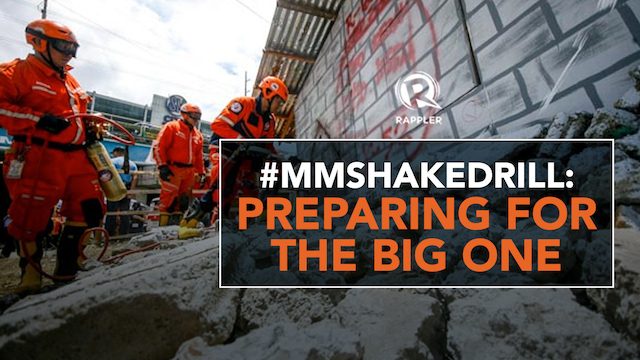SUMMARY
This is AI generated summarization, which may have errors. For context, always refer to the full article.

MANILA, Philippines – Was last Thursday’s earthquake drill realistic enough to prepare Filipinos for “the big one?”
Katerina Francisco reports.
For an hour, Metro Manila is a disaster zone.
Fires break out, hundreds are trapped under collapsed buildings, and thousands more spill onto the streets, scrambling for cover to avoid falling debris.
For the first time ever, all 17 local government units hold a metrowide earthquake drill to simulate what would happen should a powerful quake strike the metropolis.
It’s a massive event, requiring nearly two months of planning and coordination with various government agencies and local rescue units.
On July 30, the government’s disaster plans for the “Big One” are finally put to the test.
This siren signals the start of the hour-long drill.
For 45 seconds, people are encouraged to practice the “duck, cover and hold” safety routine.
Minutes later, rescue units spring into action.
Ambulances and fire trucks are mobilized to respond to the widespread damage that a 7.2 magnitude quake is expected to create.
By noon, national agencies declare the daytime drill a success.
Even international observers say it’s a good first attempt for a country as vulnerable to disasters as the Philippines.
MARK BIDDER, UN OCHA PHILIPPINES OFFICE HEAD: Such simulations are extremely important for any country subject to risks. It’s a chance for responders to come together, to coordinate their actions and work out problems they can face.
But for the message of disaster preparedness to really stick, the earthquake drill shouldn’t just be a one-time event.
For future drills, Bidder suggests something more realistic, and less staged.
MARK BIDDER, UN OCHA PHILIPPINES OFFICE HEAD: They should make it realistic as possible, you can’t predict what’s gonna happen when it’s gonna happen.
Technology can help in this regard, to play out scenarios and see best approaches and techniques to combat fires, breakdown of communications, major casualties, impact on health services, these can be played out in computer simulated environment and different techniques can be practiced.
The metrowide quake drill is an exercise in raising awareness…
but disaster officials hope that the public can translate this into disaster preparedness.
Katerina Francisco, Rappler, Manila – Rappler.com
Add a comment
How does this make you feel?
There are no comments yet. Add your comment to start the conversation.